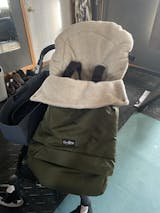WHAT SHOULD A NEWBORN SLEEP IN?
WHAT SHOULD A NEWBORN SLEEP IN?
Newborn & Infant

What should a newborn sleep in? A question that almost every future or new mom asks herself. What an infant should sleep in depends on two factors: the choice of a place to sleep and the child's age.
Co-sleeping - a baby in the parents' bed
Sleeping parents and a small child together, although it has many advantages, e.g. better sleep quality, longer sleep for the baby, facilitating breastfeeding or building an emotional bond, is associated with certain risks. Sleeping in the same bed with an infant carries the risk of being crushed and suffocated. It is recommended that the baby sleeps in a baby nest when co-sleeping with its parents. The baby cocoon (babynest) separates the space around the baby and protects it from being crushed. The edges of the cocoon ensure that the baby is safe and the parents can sleep well.
Babynests are also commonly used as a reducer for a crib. They narrow the space and create a cozy place to rest. This way, babies accept their new crib faster and learn to sleep independently.

Swaddle for a newborn - babyhorn
Apart from the place where and how the baby will sleep, its age is also influencing. For children under 9 months of age, sleeping in sleeping bags is recommended. They are recommended as the safest sleep cover. A child can cover his nose and mouth with a duvet or a pillow - it is impossible in sleeping bags. For a newborn, it is difficult to choose the right size of a sleeping bag, because the birth weight of newborns varies greatly and changes dramatically, as an alternative in the first weeks of a child's life, babyhorns are used. They provide the baby with warmth, cover, are safe and recommended by midwives. In some maternity hospitals, they are even required and included in the list of things needed for the hospital during childbirth.

Sleeping bag - safe sleep for a baby
When the baby grows out of the cone, it's best (and safest) to offer him a sleeping bag. Depending on the season and the prevailing temperature, its thickness and size should be selected. It is also worth paying attention to the materials from which it is sewn (antiallergic fillings and breathable, natural fabrics).
Cot bedding - older baby
From the 9th month, the baby can safely use the duvet and pillow. Here you should pay attention that the size of the bedding should match the size of the bed. Too large a quilt in a small crib may pose a risk of covering the baby's head while sleeping.

Peaceful sleep in comfortable conditions
The recommended optimal temperature for sleep is 66-72 degrees F. Unfortunately, it's actually hard to maintain this level, especially in summer. Therefore, you should focus on other factors that will help to ensure thermal comfort: ventilate the bedroom well before going to bed, wash bed linen regularly, remove unnecessary pillows, toys, blankets from the bed. First of all, we should adjust the child's clothes to the temperature in the room. Do not overheat your baby, as this can be more dangerous than cold, especially in newborns. Cap at room temperature is not needed. Thermal discomfort, and more precisely overheating, has a big impact on the baby's restless sleep.
Written by: Tiny Star



